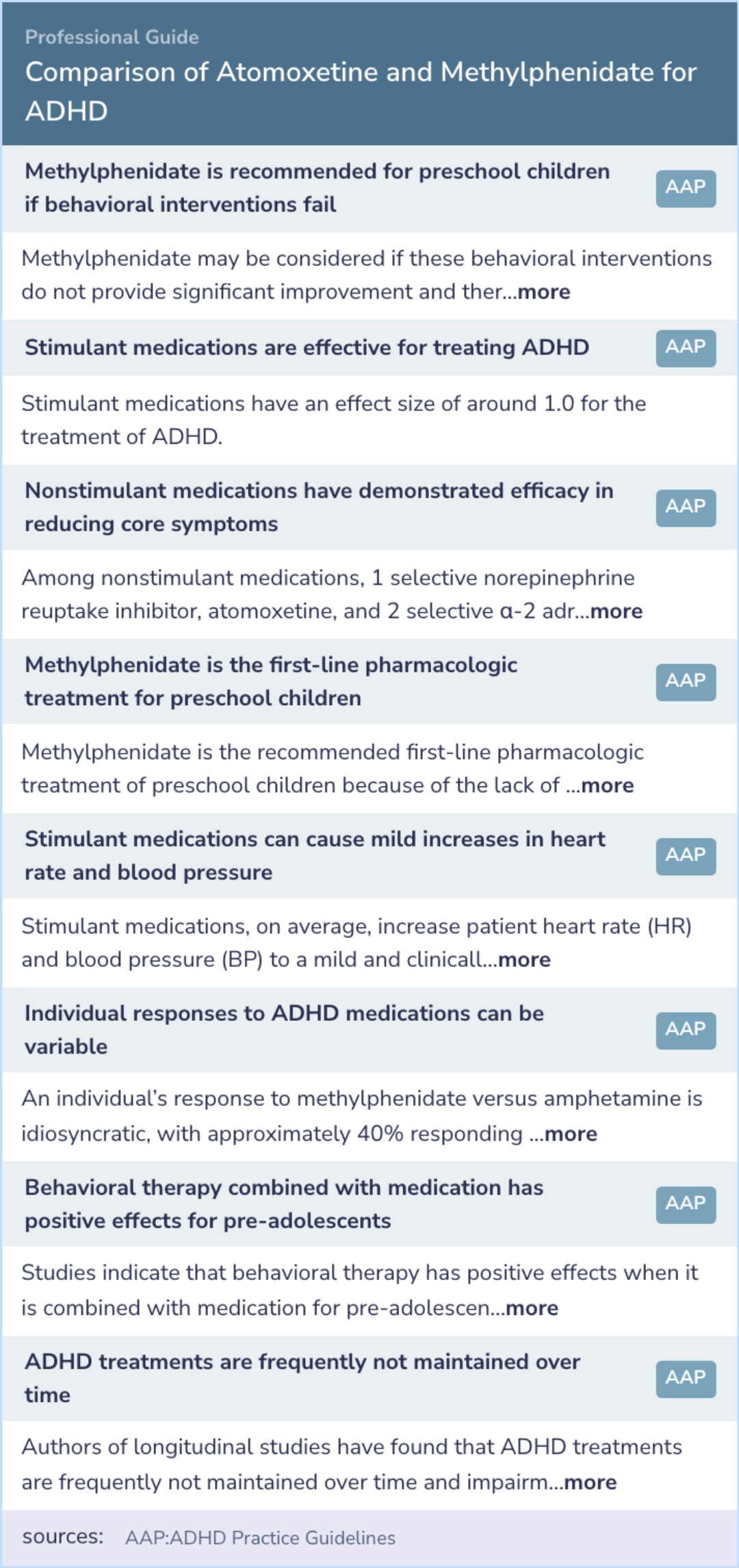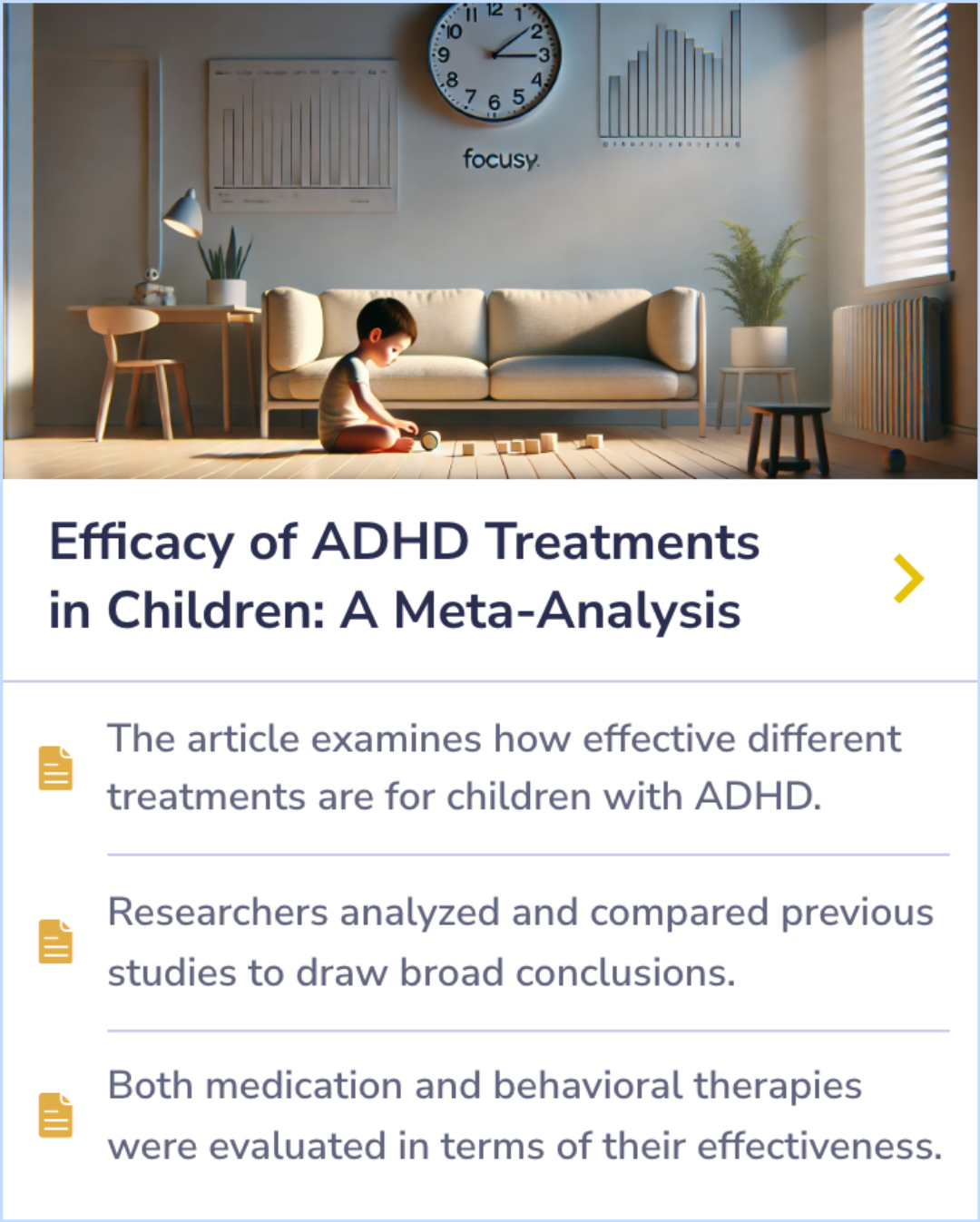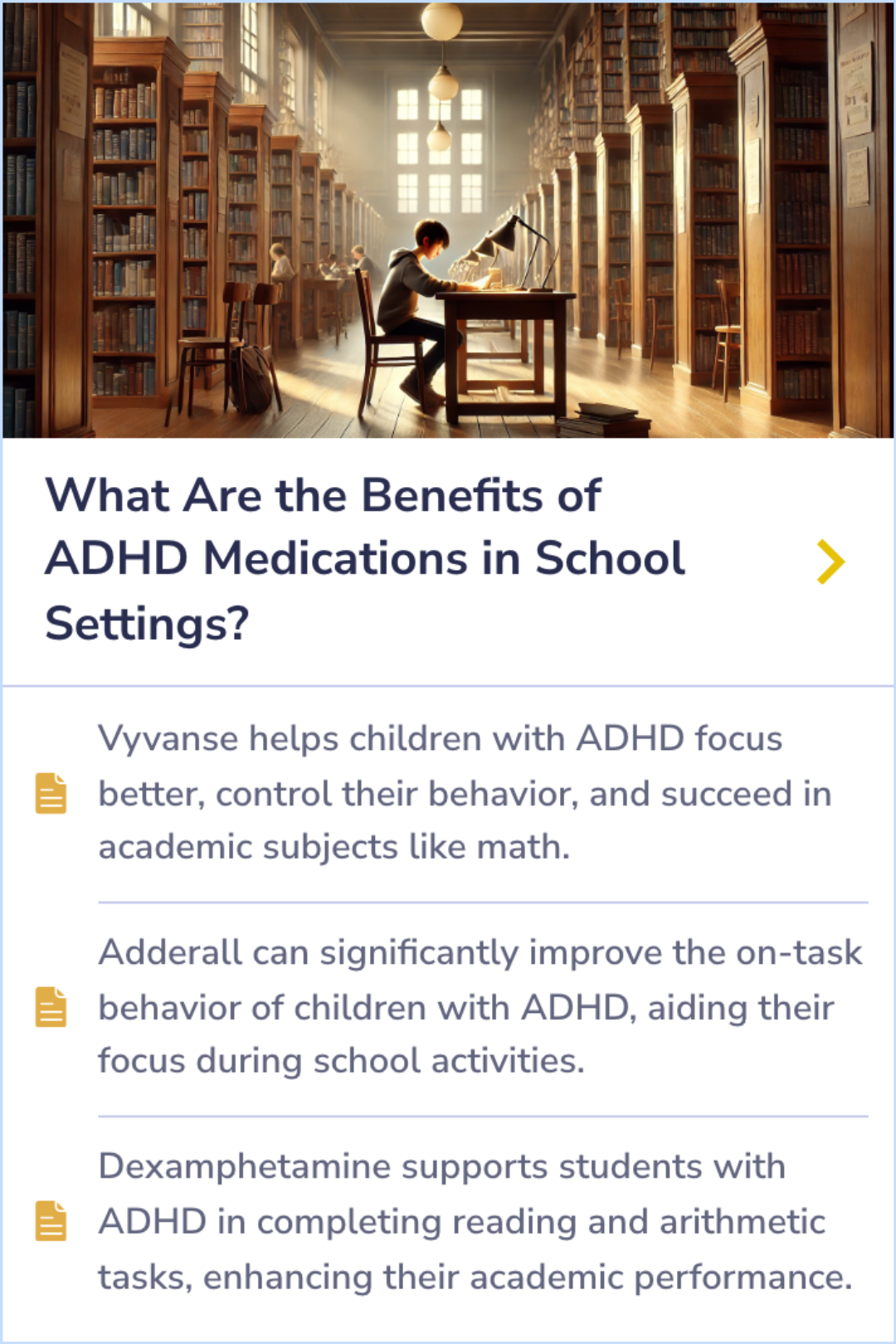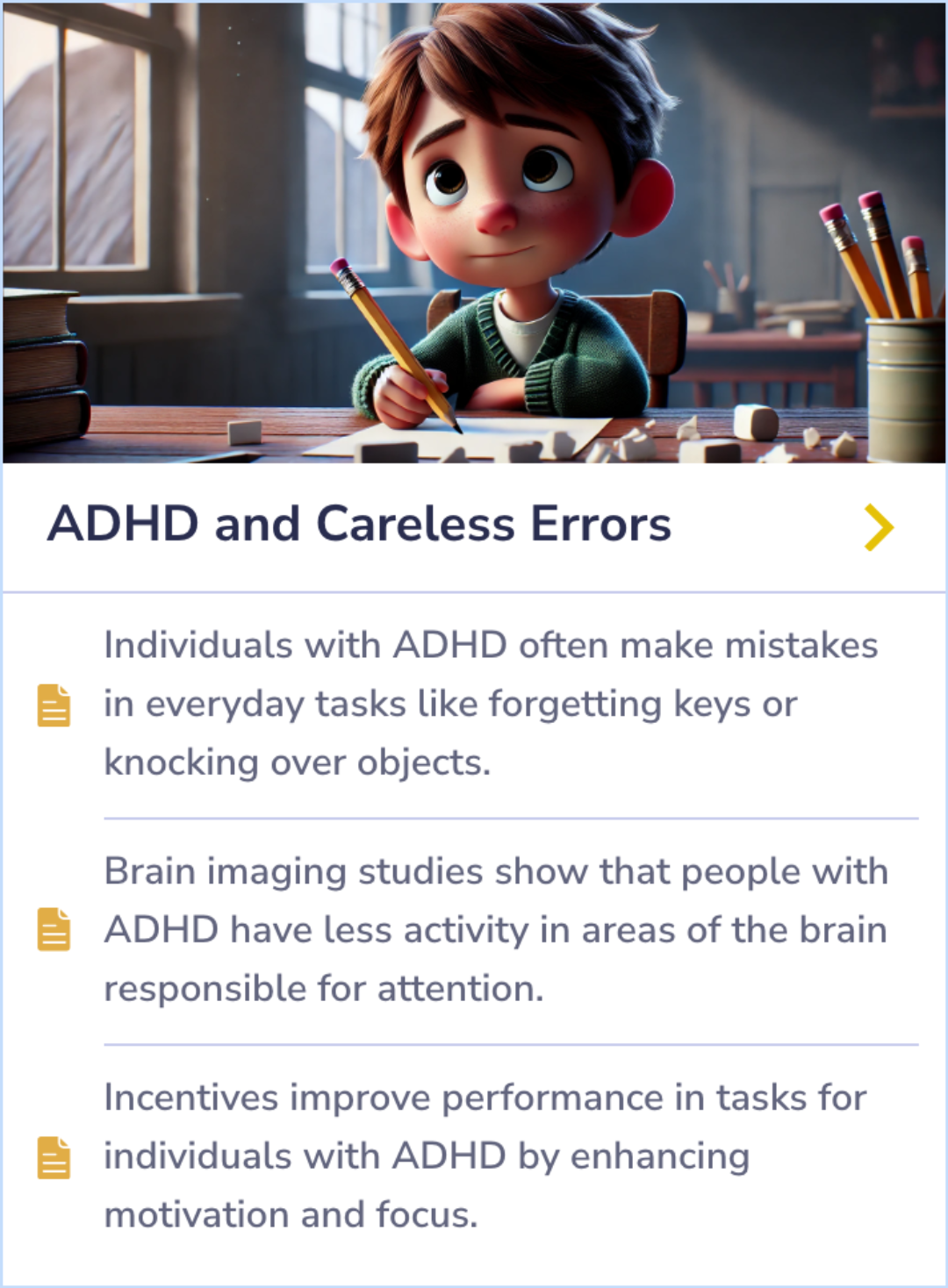Ritalin Paper Database
Visual Abstract
Atomoxetine and osmotically released methylphenidate for the treatment of attention deficit hyperactivity disorder: acute comparison and differential response
Comparison of Atomoxetine and Methylphenidate for ADHD
August 27, 2024
author
Newcorn JH, Kratochvil CJ, Allen AJ, Casat CD, Ruff DD, Moore RJ, Michelson D; Atomoxetine/Methylphenidate Comparative Study Group
journal
Am J Psychiatry
Date Published
2008 Jun
Why link to a visual abstract?
What is a visual abstract?
Original
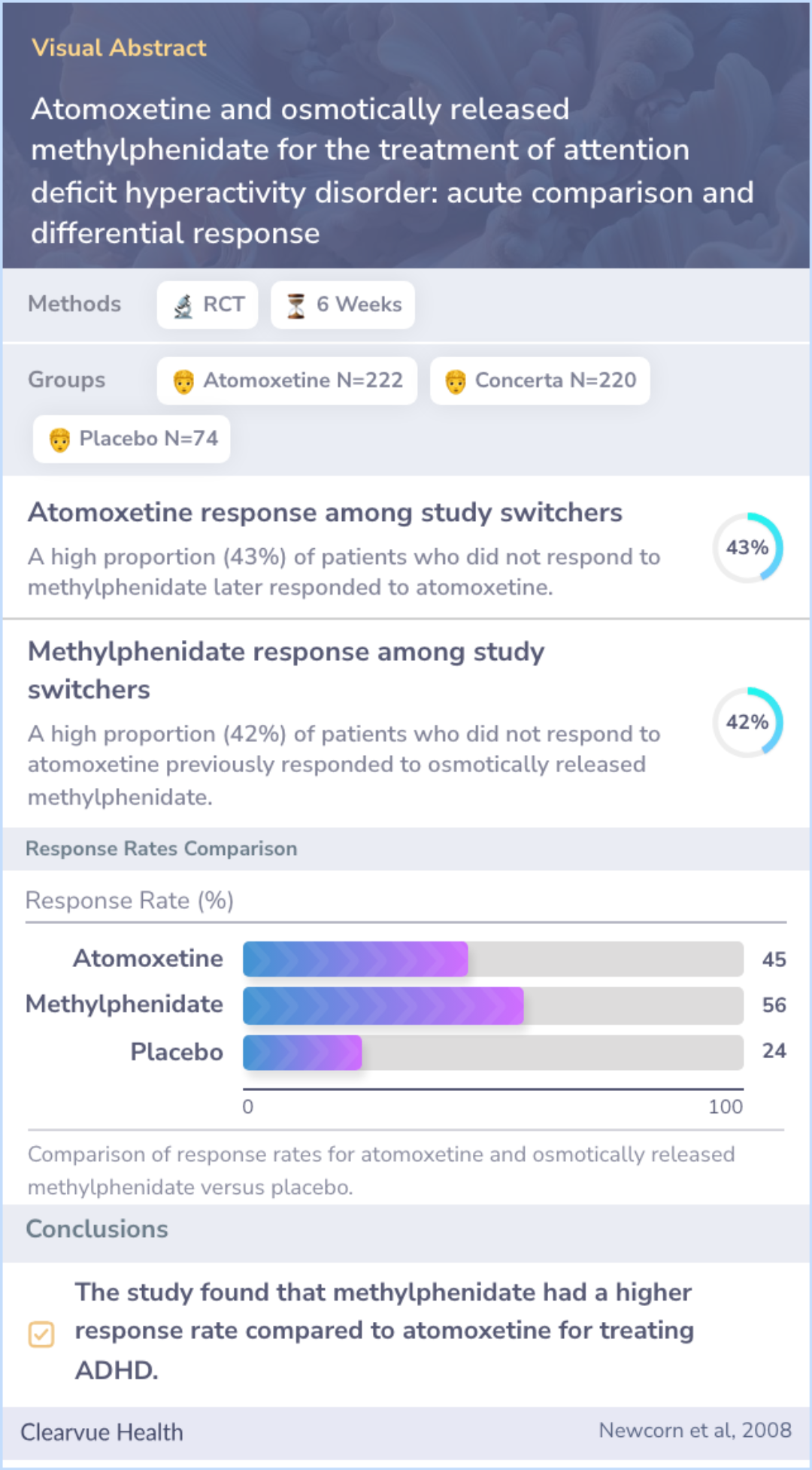
Study Summary
🔬
What They Studied
The researchers studied the effectiveness of atomoxetine versus Concerta (osmotically released oral methylphenidate) in treating ADHD in children and adolescents.
💡
What They Found
They found that Concerta (osmotically released oral methylphenidate) had a higher response rate than atomoxetine in treating ADHD.
📚
What This Means
These findings suggest that Concerta (osmotically released oral methylphenidate) is more effective than atomoxetine for treating ADHD, which aligns with current evidence that supports its use as a primary treatment.
Study Summary
Study Overview
This study aimed to compare the effectiveness of two ADHD treatments: atomoxetine and methylphenidate. While methylphenidate is a well-established treatment, atomoxetine offers a non-stimulant alternative. The researchers explored how patients responded to each medication, particularly focusing on those who might not respond to the first treatment option.
The findings revealed that while methylphenidate generally performed better, atomoxetine was still effective for a significant number of patients. Importantly, some patients responded better to one drug over the other, suggesting that individual responses to ADHD medications can vary widely. This underscores the need for personalized treatment approaches in managing ADHD.
The findings revealed that while methylphenidate generally performed better, atomoxetine was still effective for a significant number of patients. Importantly, some patients responded better to one drug over the other, suggesting that individual responses to ADHD medications can vary widely. This underscores the need for personalized treatment approaches in managing ADHD.
Abstract: background
Response to atomoxetine, a nonstimulant norepinephrine-specific reuptake inhibitor, was compared with the effect of osmotic-release oral methylphenidate, a long-acting methylphenidate preparation, in patients with attention deficit hyperactivity diso...more

Comparison of Effectiveness
"The magnitude of response to atomoxetine is presented in the context of a frequently used, long-acting stimulant comparator. While atomoxetine did not perform as well as osmotically released methylphenidate overall, response to atomoxetine was nevertheless solid, with an effect size within 0.2 of that achieved for methylphenidate."
Clinical Importance of Individual Responses
"The finding that there are subgroups of patients who respond preferentially to osmotically released methylphenidate or atomoxetine is of considerable clinical importance and provides at least some empirical support for clinical guidelines that recommend using a second medication class if treatment with the first agent is unsatisfactory."
Patient-Specific Treatment Responses
"Another important finding relates to the group of patients switched to atomoxetine after completing 6 weeks of methylphenidate. About one-half of these subjects responded robustly to both treatments. However, approximately two-thirds of the others responded preferentially to one treatment, divided approximately equally between methylphenidate and atomoxetine."
Study Summary
Methods
In this large, carefully controlled study, 516 patients aged 6-16 with any type of ADHD were randomly divided into three groups. One group received daily doses of atomoxetine (222 patients), another group received daily doses of osmotically released methylphenidate (220 patients), and the last group received a placebo (74 patients) for 6 weeks. The main goal was to measure if there was at least a 40% decrease in ADHD symptoms. After 6 weeks, those on methylphenidate were switched to atomoxetine in a blinded manner.
Abstract: methods
In a large placebo-controlled, double-blind study, patients ages 6-16 with ADHD, any subtype, were randomly assigned to receive 0.8-1.8 mg/kg per day of atomoxetine (N=222), 18-54 mg/day of osmotically released methylphenidate (N=220), or placebo (N=...more

Study Summary
Results
Both atomoxetine (45%) and methylphenidate (56%) had significantly higher response rates compared to placebo (24%). However, osmotically released methylphenidate was more effective than atomoxetine. Both drugs were generally well tolerated, with similar completion rates and adverse event dropouts to placebo. Interestingly, 43% of participants who didn’t respond to methylphenidate later responded to atomoxetine, and 42% of those who didn’t respond to atomoxetine had previously responded to methylphenidate.
Abstract: results
The response rates for both atomoxetine (45%) and methylphenidate (56%) were markedly superior to that for placebo (24%), but the response to osmotically released methylphenidate was superior to that for atomoxetine. Each medication was well tolerate...more

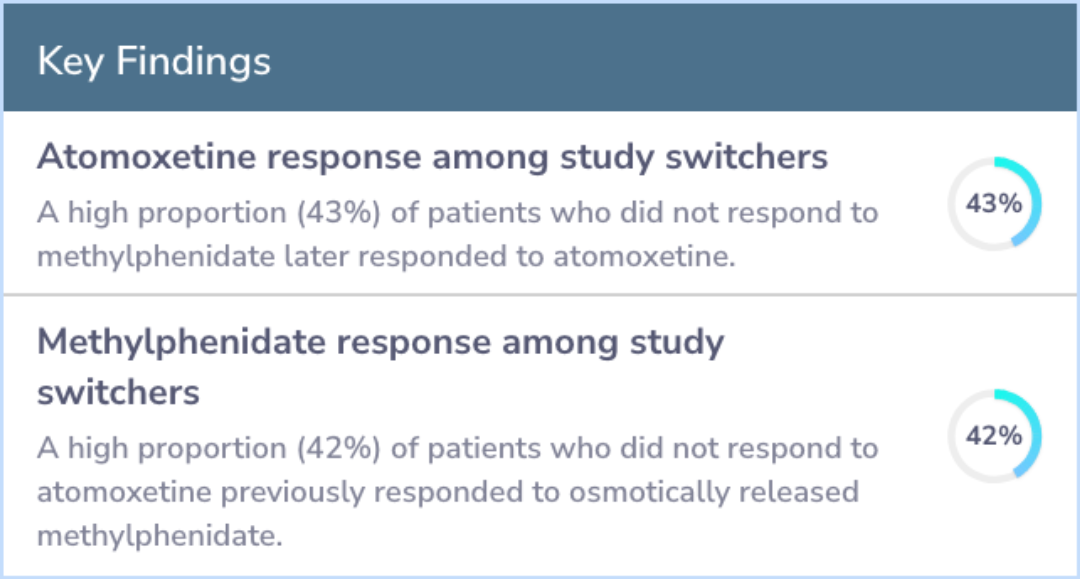
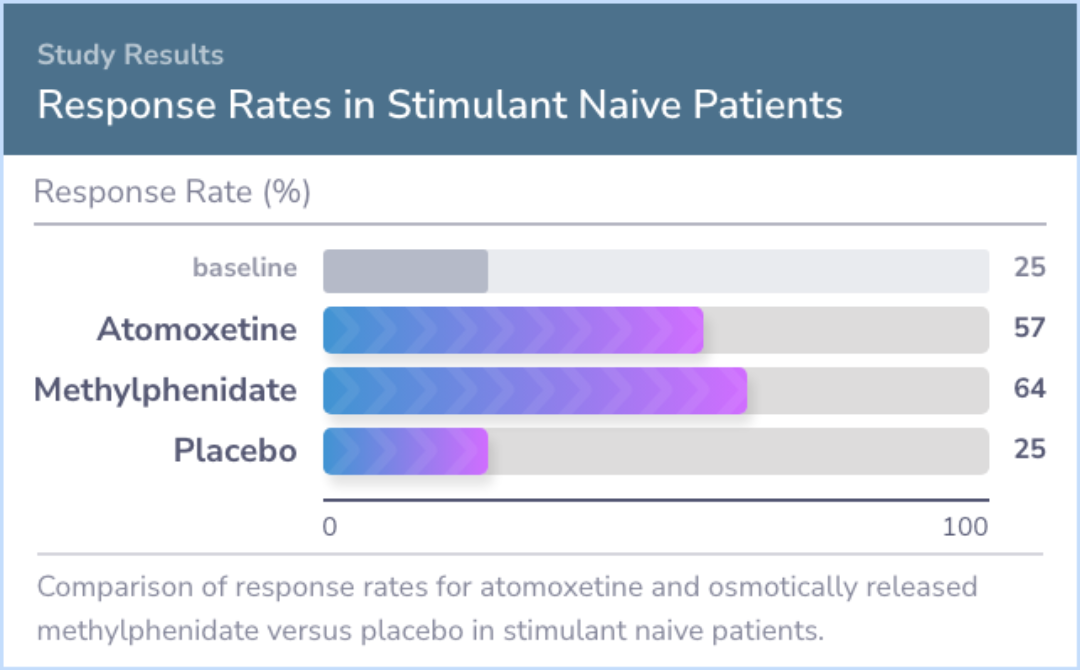
Study Summary
Conclusions
The study found that osmotically released methylphenidate was more effective in reducing ADHD symptoms than atomoxetine. Additionally, about one-third of the patients who switched from one medication to the other showed better responses, indicating that some individuals may respond preferentially to one medication over the other.
Abstract: conclusions
Response was significantly greater with osmotically released methylphenidate than with atomoxetine. One-third of patients who received methylphenidate followed by atomoxetine responded better to one or the other, suggesting that there may be preferen...more
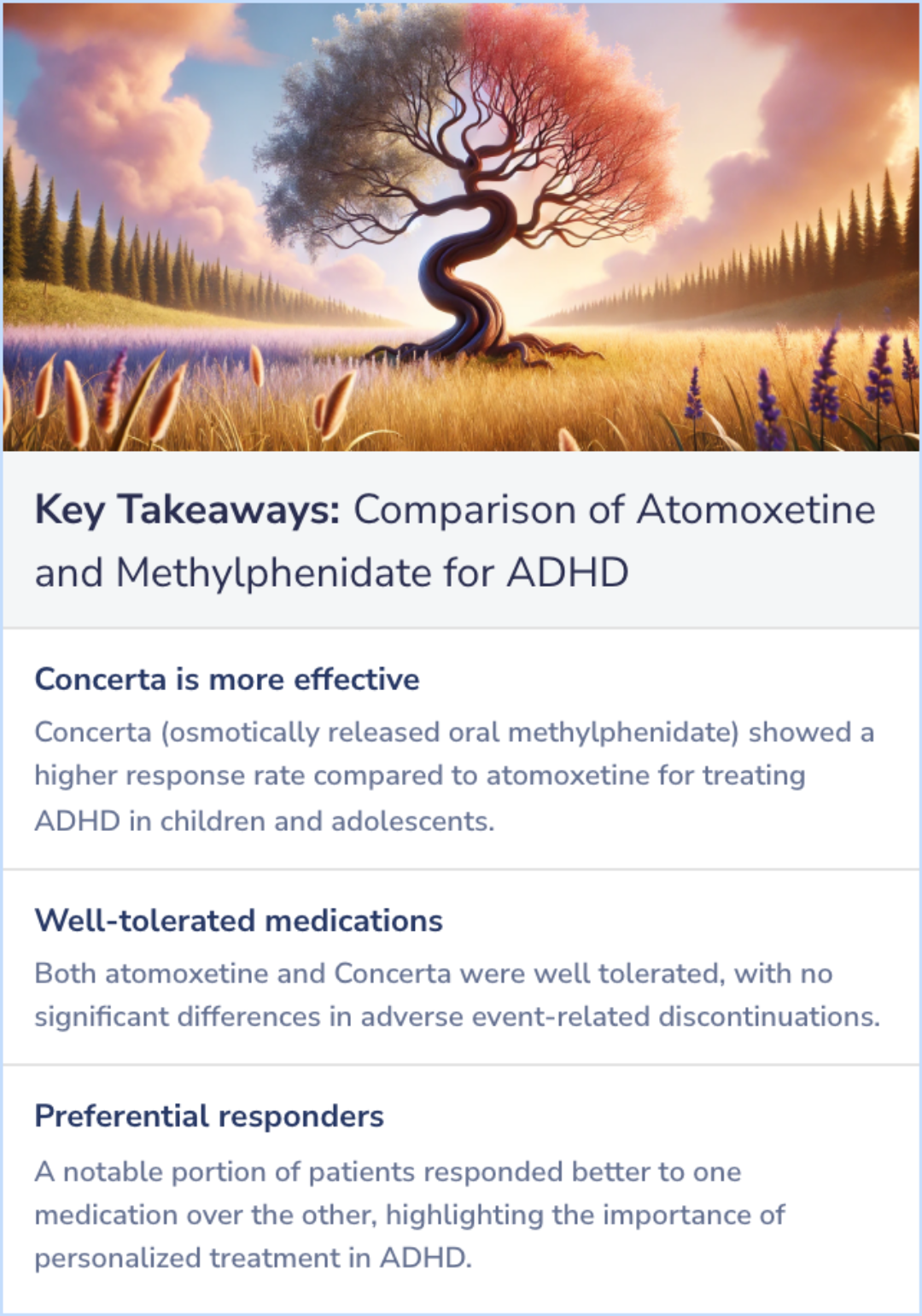
Background Information
Patient Guide
👨⚕️
FDA Approval
Methylphenidate is FDA-approved for treating ADHD in children and adults.
🧠
Mechanism of Action
Methylphenidate blocks the reuptake of norepinephrine and dopamine, increasing synaptic concentration.
🧒
Age Requirement
Children must be six years or older to be prescribed methylphenidate for ADHD.
💊
Formulation Options
Methylphenidate is available in immediate-release, extended-release, and sustained-release formulations.
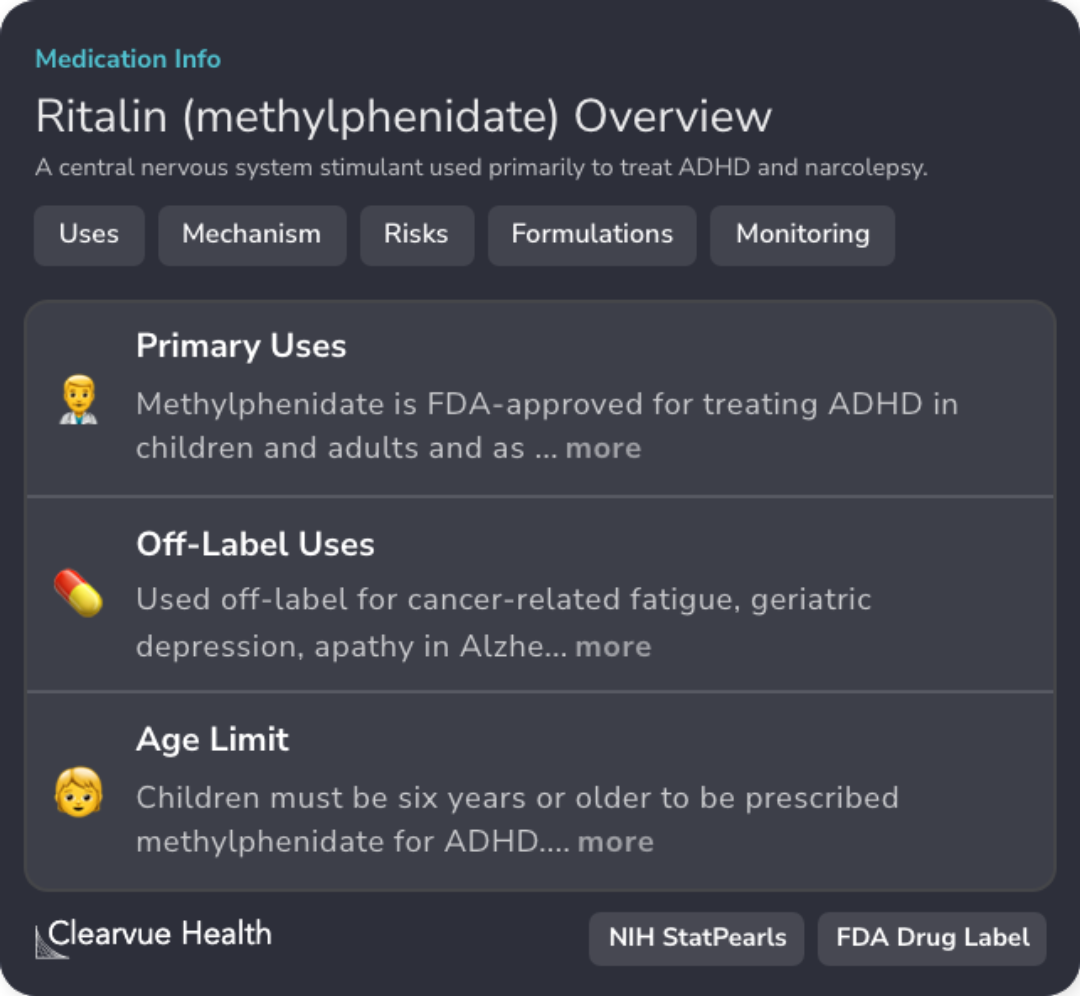
Professional Guide
Expert Opinion: Comparison of Atomoxetine and Methylphenidate for ADHD
In line with the abstract's comparison of atomoxetine and methylphenidate, current professional recommendations offer further insights into ADHD treatment.
Methylphenidate is recommended when behavioral interventions fail in preschool children and is the first-line pharmacologic treatment due to limited studies on nonstimulant medications for this age group.
Stimulant medications show high effectiveness for treating ADHD with notable effect sizes.
However, nonstimulant medications like atomoxetine also demonstrate efficacy, albeit with smaller effect sizes.
Importantly, individuals’ responses to ADHD medications can be highly variable, consistent with the observation of different responses to methylphenidate and atomoxetine in the study.
Methylphenidate is recommended when behavioral interventions fail in preschool children and is the first-line pharmacologic treatment due to limited studies on nonstimulant medications for this age group.
Stimulant medications show high effectiveness for treating ADHD with notable effect sizes.
However, nonstimulant medications like atomoxetine also demonstrate efficacy, albeit with smaller effect sizes.
Importantly, individuals’ responses to ADHD medications can be highly variable, consistent with the observation of different responses to methylphenidate and atomoxetine in the study.
Study Summary
Conclusions
The study found that osmotically released methylphenidate was more effective in reducing ADHD symptoms than atomoxetine. Additionally, about one-third of the patients who switched from one medication to the other showed better responses, indicating that some individuals may respond preferentially to one medication over the other.
Abstract: conclusions
Response was significantly greater with osmotically released methylphenidate than with atomoxetine. One-third of patients who received methylphenidate followed by atomoxetine responded better to one or the other, suggesting that there may be preferen...more

Evidence Summary
Evaluating ADHD Treatments: Medication vs. Behavioral Therapy
The article reviews how well various treatments work for children diagnosed with ADHD by analyzing several studies.
Both medications and behavioral therapies were evaluated to observe their overall impact and effectiveness.
Researchers analyzed and compared previous studies to draw broad conclusions.
Both medication and behavioral therapies were evaluated in terms of their effectiveness.
Both medications and behavioral therapies were evaluated to observe their overall impact and effectiveness.
Researchers analyzed and compared previous studies to draw broad conclusions.
Both medication and behavioral therapies were evaluated in terms of their effectiveness.
Evidence Summary
How ADHD Medications Enhance Classroom Performance
ADHD medications like Vyvanse, Adderall, and Dexamphetamine significantly enhance students' focus and on-task behavior.
Vyvanse helps children with ADHD focus better, control their behavior, and excel in academic subjects like math.
Adderall improves on-task behavior during school activities, aiding concentration.
Dexamphetamine supports students in completing reading and arithmetic tasks, boosting academic performance.
Vyvanse helps children with ADHD focus better, control their behavior, and excel in academic subjects like math.
Adderall improves on-task behavior during school activities, aiding concentration.
Dexamphetamine supports students in completing reading and arithmetic tasks, boosting academic performance.
Evidence Summary
Effectiveness of ADHD Treatments: Atomoxetine vs. Methylphenidate
Researchers evaluated the effectiveness of different ADHD treatments by analyzing various studies.
The focus was on both medication and behavioral therapies.
This review included treatments like atomoxetine and methylphenidate, highlighting their overall impact.
By comparing multiple studies, the article provides a comprehensive overview of how these treatments perform in managing ADHD symptoms.
The focus was on both medication and behavioral therapies.
This review included treatments like atomoxetine and methylphenidate, highlighting their overall impact.
By comparing multiple studies, the article provides a comprehensive overview of how these treatments perform in managing ADHD symptoms.
